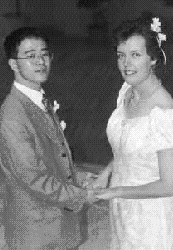
University of Alberta
Edmonton, CanadaJune 13, 1997

|
University of AlbertaEdmonton, CanadaJune 13, 1997 |
By Carol Brandly (BA '93)

husband Toshiaki |
I first met Toshiaki when I was on a one-year exchange to Shizuoka University from the U of A. During my time there studying Japanese literature, I became involved in an informal haiku circle. Toshiaki, who loved writing haiku and other poetry, was the organizer of this circle. Japanese haiku and tanka poetry appealed to me because one can compose them without necessarily worrying if it is "good" or not. My poems are certainly no masterpieces, but I enjoy writing them and I'm amazed how easily I can express my feelings through such an economy of words.
The Japanese have used poetry as a way of communicating with each other for well over a thousand years, and this is exactly how Toshiaki and I got to know each other. When I returned to Japan on the JET Programme, I decided to write to Toshiaki, who was then still just an acquaintance. I sent him a couple of tanka which I had written for a Japanese 418 assignment, one of which is as follows:
About a month later, to my amazement I received a ten page letter from him which included his translations of my tanka into Japanese along with some of his own poetry. He apparently found deep meaning in my poetry, and it sparked his curiosity. He told me that he worried what darkness was in my heart and also praised me on my insight into human denial of the evil in everyday life... Actually that tanka was just about a lunar eclipse I saw outside of overcast Edmonton. The darkness was simply the pressure of all my Japanese assignments weighing down on me. Nevertheless, it served its purpose in getting Toshiaki interested in me!
I then wrote to Toshiaki and asked him to accompany me on a walk on "Yama no be no michi," an ancient road in Nara, and he agreed. During the walk we came across a small and unusually calm pond where the haiku poet Basho had paused and written a poem centuries earlier. Toshiaki was inspired by this and sent me his haiku a week later at Christmas:
|
The wintry wind
Hides its breath In the pond's depths |
Toshiaki and I went on to exchange dozens of haiku and tanka over the next few years, and this January, we were married. I'd like to thank Sonja Arntzen because if it were not for that tanka she asked us to write in Japanese 418, I might never have found my true love. And as Sonja advised us, I would like to continue to "keep the poetry in our relationship" for years to come.
*Reprinted with permission from the East Asian Studies Alumni Association Newsletter.
![[Folio]](http://www.ualberta.ca/~publicas/folio/gif/old/small/folio.gif)
Folio front page |
![[Office of Public Affairs]](http://www.ualberta.ca/~publicas/gif/small/opahome.gif)
Office of Public Affairs |
![[University of Alberta]](http://www.ualberta.ca/~publicas/gif/small/uahome.gif)
University of Alberta |